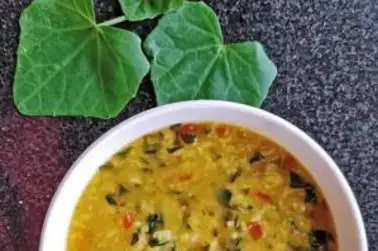Instead of chasing produce from across the world, rediscover local greens that are a powerhouse of taste and good health
There is constant tussle between the spouse and I about the tiny strip in front of our home that we call our garden. He thinks it should have lovely plants, prettily lined up, whereas I am all about letting everything stay/grow indiscriminately. I am loathe to pluck anything even remotely useful. I will keep the tulasi and keezhanelli (stone breaker or seed-under-leaf plant, known for its extensive use in curing liver-related complaints) growing outside the beds.
Thanks to the wild garden, there is a bounty of uncultivated greens. Baby Akka, who manages our home and garden, is a veritable encyclopaedia on these plants and their uses. A full-time farmer until 15 years ago, she moved to the city after being widowed. Her knowledge and fascination with these greens humbles me. The first time I had a cough she quickly went to the garden, plucked a few leaves from a thorny creeper and told me to make rasam with it. It was the tuduvalai plant (climbing brinjal) that is traditionally used for curing cough and asthma.
My interest in these uncultivated food plants grew after the drought last summer. The scanty garden dried up as the summer progressed. However I noticed that our Ceylon keerai (waterleaf plant) survived and continued to flourish. With its succulent leaves and pretty pink flowers; it grew wild between flagstones, under the bamboo trees… everywhere. Other than the small quantity I use to make a delicious dal, the rest I am forced to compost as nobody seems to want it. What a waste of a wonderful food, full of vitamin C, E, calcium, fibre, potassium and many other elements, making it a nutritional powerhouse.
Another beauty in the garden that I have fallen in love with is Kovakkai keerai (Ivy gourd leaves). The variety we have strangely doesn’t fruit and flowers rarely. The first time one of the farmers showed me the plant and told me its benefits, I realised that this was the same creeper I was indiscriminately uprooting and throwing into the compost. Now this is a regular addition to our dals and I think both this and the Ceylon keerai would make great additions to soups. Rich in beta carotene, the ivy gourd leaves have numerous healing properties.
Another discovery that I have eaten and relished but not dared prepare is the pirandai keerai (Veldt grape) high on medicinal properties; again Baby Akka is my guide to it. With its exotic, succulent, squarish stem and beautiful leaves, it grows lustily wrapping its tendrils around every other plant nearby. The tender stem is great to prepare thuviyal. It has to be sautéed in oil and used along with tamarind, as otherwise it can cause itchiness in the throat.
As part of the Save Our Rice Campaign, a study conducted in unsprayed paddy fields in Wayanad led to the discovery of 96 varieties of uncultivated greens all identified by older women and tribal community members. These were regularly consumed till modern vegetables made their way into the local diet.
It is not that I am a complete convert to eating these keerais. I am very much the spoilt urbanite who likes the sweetness of palak, and enjoys the ease of cooking vegetables that don’t require attention and skill from me. However, the more I see micro-nutrient deficiencies among us, I learn that the best diet is what our ancestors ate. Above all, when I experience the vagaries of climate change, I realise that the luxury of cultivated vegetables has to be tempered with the pleasures of uncultivated greens. I have to learn to use them seamlessly in my daily diet and cultivate the palate to enjoy these uncultivated foods.
Each of us will find different greens growing in our backyards. The time has come to find nutrition in these plants that grow easily and make the ordinary exotic, rather than chase the exotic from across the world. The taste for exotics is cultivated, so why not cultivate a taste for the ordinary?




























